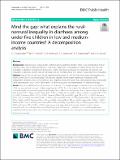Mind the gap : what explains the rural-nonrural inequality in diarrhoea among under-five children in low and medium-income countries? A decomposition analysis
Abstract
Background: Diarrhoea poses serious health problems among under-five children (U5C) in Low-and Medium-Income Countries (LMIC) with a higher prevalence in rural areas. A gap exists in knowledge on factors driving rural-non-rural inequalities in diarrhoea development among U5C in LMIC. This study investigates the magnitude of rural-non-rural inequalities in diarrhoea and the roles of individual-level and neighbourhood-level factors in explaining these inequalities. Methods: Data of 796,150 U5C, from 63,378 neighbourhoods across 57 LMIC from the most recent Demographic and Health Survey (2010–2018) was analysed. The outcome variable was the recent experience of diarrhoea while independent variables consist of the individual- and neighbourhood-level factors. Data were analysed using multivariable Fairlie decomposition at p <0.05 in Stata Version 16 while visualization was implemented in R Statistical Package. Results: Two-thirds (68.0%) of the children are from rural areas. The overall prevalence of diarrhoea was 14.2, 14.6% vs 13.4% among rural and non-rural children respectively (p <0.001). From the analysis, the following 20 countries showed a statistically significant pro-rural inequalities with higher odds of diarrhoea in rural areas than in nonrural areas at 5% alpha level: Albania (OR = 1.769; p = 0.001), Benin (OR = 1.209; p = 0.002), Burundi (OR = 1.399; p <0.001), Cambodia (OR = 1.201; p <0.031), Cameroon (OR = 1.377; p <0.001), Comoros (OR = 1.266; p = 0.029), Egypt (OR = 1.331; p <0.001), Honduras (OR = 1.127; p = 0.027), India (OR = 1.059; p <0.001), Indonesia (OR = 1.219; p <0.001), Liberia (OR = 1.158; p = 0.017), Mali (OR = 1.240; p = 0.001), Myanmar (OR = 1.422; p = 0.004), Namibia (OR = 1.451; p <0.001), Nigeria (OR = 1.492; p <0.001), Rwanda (OR = 1.261; p = 0.010), South Africa (OR = 1.420; p = 0.002), Togo (OR = 1.729; p <0.001), Uganda (OR = 1.214; p <0.001), and Yemen (OR = 1.249; p <0.001); and pro-non-rural inequalities in 9 countries. Variations exist in factors associated with pro-rural inequalities across the 20 countries. Overall main contributors to pro-rural inequality were neighbourhood socioeconomic status, household wealth status, media access, toilet types, maternal age and education. Conclusions: The gaps in the odds of diarrhoea among rural children than nonrural children were explained by individual-level and neighbourhood-level factors. Sustainable intervention measures that are tailored to country-specific needs could offer a better approach to closing rural-non-rural gaps in having diarrhoea among U5C in LMIC.
Citation
Fagbamigbe , A F , Oyinlola , F F , Morakinyo , O M , Adebowale , A S , Fagbamigbe , O S & Uthman , A O 2021 , ' Mind the gap : what explains the rural-nonrural inequality in diarrhoea among under-five children in low and medium-income countries? A decomposition analysis ' , BMC Public Health , vol. 21 , 575 . https://doi.org/10.1186/s12889-021-10615-0
Publication
BMC Public Health
Status
Peer reviewed
ISSN
1471-2458Type
Journal article
Description
Funding: CARTA is jointlyled by the African Population and Health Research Center and the University of the Witwatersrand and funded by the Carnegie Corporation of New York (Grant No--B 8606.R02), Sida (Grant No: 54100029), and the DELTAS Africa Initiative (Grant No: 107768/Z/15/Z).Collections
Items in the St Andrews Research Repository are protected by copyright, with all rights reserved, unless otherwise indicated.

